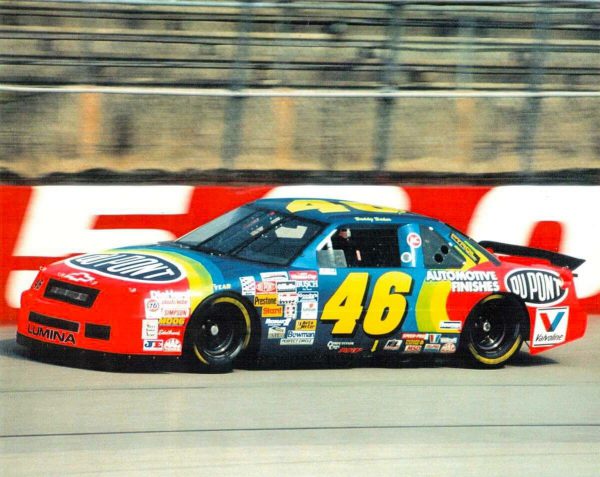
Few cars in NASCAR’s modern history have engendered more online discussion than Hendrick Motorsports chassis 2405. It’s not a car that has a particularly famous on-track record, but it has built an impressive following among fans who have seen a photo of the car, on jackstands, dressed in Jeff Gordon’s familiar DuPont Automotive Finishes colors. The car looked exceedingly familiar, but it had an unfamiliar number: 46.
Gordon was originally going to wear the No. 46 on the sides of his cars throughout his rookie season in 1993, three years after Days of Thunder was released. But the licensing agreements put in place for the blockbuster movie precluded the number being used, at least on a full-time basis. The team did get clearance to use the number for a one-off attempt at Talladega Superspeedway in July of that season, but future NASCAR Hall of Famer Buddy Baker missed the starting field by just 0.02 seconds.
After that ignominious outing, Hendrick Motorsports sold the car to an Iowa businessman who wanted to go superspeedway racing. Little did anyone know it would be the impetus to a dynasty that lasted nearly 15 years.
Larry Clement brought the car, still painted in the “Rainbow Warrior” colors with the number 46 on the side, to the 1993 ARCA Menards Series season finale Atlanta with veteran dirt track racer Bob Hill at the wheel. Still in its infancy with a driver that had never raced on a track that large or fast before, Clement’s new team performed well. Hendrick chassis 2405 carried Hill to a top-five finish – fourth – and laid the first brick in a foundation that would result in 75 victories and nine series championships.
Hill qualified the car third out of 75 entries at the 1994 season opener at Daytona and was in the hunt for the win before he was blocked on pit road during a late-race pit stop and was relegated to seventh at the finish. The likeable Iowan delivered Clement’s first ARCA win on the mile dirt at Springfield in 1994, and would go on to three more victories, all on one-mile dirt tracks, at the Indiana State Fairgrounds and DuQuoin State Fairgrounds. Hill would also make the highlight reel for the team as he and his on-board camera rode out a wild flip in the 1996 season opener at Daytona.
Clement recalled his team’s first starts as the ARCA Menards Series prepares to race at the track he was instrumental in getting built, Iowa Speedway.
“There were 14 drivers in the race with NASCAR Cup Series experience,” he said, recalling the 1993 race at Atlanta. “Our driver, Bob Hill, finished fourth because we got a lap down on a green-flag pit stop one lap before a yellow flag. He ran right with the three lead lap cars. It was his first asphalt race. That was the year, 1993, that he won the NASCAR Busch All-star tour championship for dirt late models, an incredibly competitive series. Bob went on to win four ARCA races before taking a job with the SABCO NASCAR team as shop foreman. That’s when we joined with Frank Kimmel, who had one ARCA win, but had unlimited potential. As they say, the rest is history.”
It was in 1996 that Clement teamed up, on a part-time basis, with a short track ace out of Clarksville, Indiana who had started to make a name in the ARCA Menards Series. Frank Kimmel was racing the bulk of the short tracks and the occasional superspeedway event for owner Don Falldorf. The two owners worked out a deal to share the car number, still 46, to keep both Hill and Kimmel high enough in owner points. Kimmel won three times for Falldorf while carrying Clement’s car number in 1996 and earned a full-time ride in Clement’s cars in 1997.
The Clement/Kimmel combination started slowly, with just one win in 1997 but exploded in 1998 when they earned nine wins and the duo’s first series championship. After finishing second in the series standings in 1999, they combined to make stock car history when they scored eight consecutive series championships. Over those eight years, Kimmel found the path to victory lane an astounding 54 times.
Clement also discussed the role ARCA played in getting the track up and running.
“If it wasn’t for ARCA, the speedway would not exist,” Clement said. “It was at an ARCA driver’s meeting at Michigan in 1996 that ARCA president Ron Drager introduced a group who were going to be partners with Bruton Smith and build a track in Illinois. When that didn’t happen, they moved the project to eastern Iowa and eventually to Newton. Ron and ARCA were the first series to commit a race to the track. ARCA has raced at Iowa more times than any other series since.”
Clement will be honored for his accomplishments as an owner during pre-race activities leading up to the Shore Lunch 150 at Iowa Speedway in Newton on Saturday, July 24. Clement will participate in the autograph session held on the fan concourse at 6:45 pm CT, just prior to driver introductions and he will have chassis 2405 on display as well.
Discounted tickets to the Shore Lunch 150 at Iowa Speedway are available at Menards stores throughout Iowa for just $20.
ARCA PR





